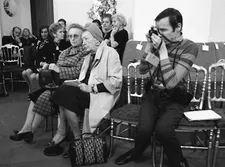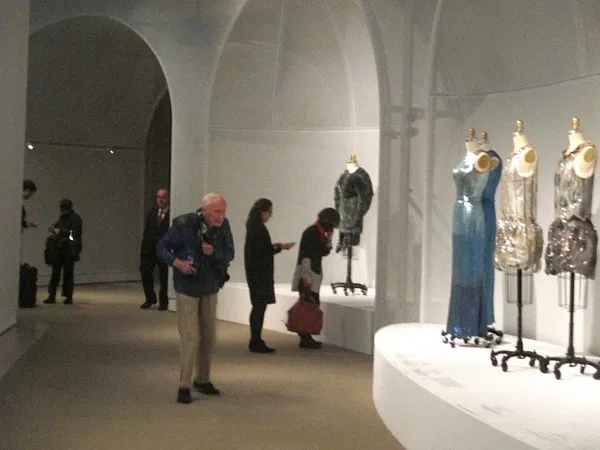 |
| Bill Cunningham on the move at The Metropolitan Museum of Art Costume Institute Manus x Machina: Fashion in an Age of Technology press preview. Photo: Anne-Katrin Titze |
The last time I encountered Bill Cunningham was on the first Monday in May of 2016 at The Metropolitan Museum of Art Costume Institute Manus x Machina: Fashion in an Age of Technology press preview. The exhibition, organised by Andrew Bolton, Wendy Yu Curator in Charge of The Costume Institute, included the work of Rei Kawakubo (Comme des Garçons), Karl Lagerfeld (Chanel), Yves Saint Laurent (Christian Dior, Yves Saint Laurent), Raf Simons (Christian Dior), Miuccia Prada, Pierre Cardin, Gabrielle Chanel, and Yohji Yamamoto.
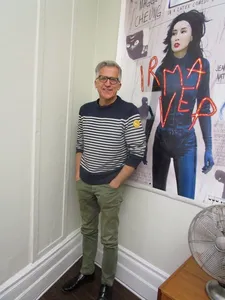 |
| Mark Bozek on Bill Cunningham: “I'd point him in one direction and suddenly he'd go 20 minutes on Diana Vreeland.” Photo: Anne-Katrin Titze |
James Crump's documentary Antonio Lopez 1970: Sex Fashion & Disco, Richard Press’s Bill Cunningham New York and Kate Novack's The Gospel According To André entered into the first instalment of my in-depth conversation with Mark Bozek on his The Times Of Bill Cunningham, narrated by Sarah Jessica Parker and dedicated to Isabel Toledo.
Bill Cunningham could snap a photograph at the very moment you spotted him. At the centre of the documentary is an interview with him, conducted by Bozek in 1994, where he opens up about his career as a fashion historian and what really matters. Previously unseen pictures from Bill’s immense archive tumble out onto the screen, a feast for the eyes. And the mind, because the icon’s vigilant gaze never ceases to confront us with the larger context each outfit contains and connects.
Anne-Katrin Titze: At times in your film it feels that Bill Cunningham really wanted to express himself. There is so much built up in him, you can sense.
Mark Bozek: I think in retrospect, that's what his friends have shared with me. I showed it to all his friends six months after. I took the raw interview, took a screening room and invited some of his friends. Ruben and Isabel Toledo especially. I wanted to show it to them first - that I was being pure in what I was doing.
The other movie [Richard Press’s Bill Cunningham New York] that had come out was great and very well received, but this was a different perspective. He was much younger. They said to me that he did have a lot to say because I just happened to be chosen on that day that he felt comfortable enough to share it. Because I wasn't a fashion expert, certainly wasn't a serious journalist, he just wanted to talk. And I realised an hour or so in, that I should just be quiet. I'd point him in one direction and suddenly he'd go 20 minutes on Diana Vreeland.
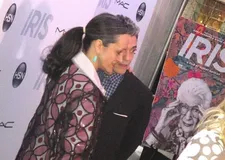 |
| Mark Bozek on Isabel Toledo and Ruben Toledo with Bill Cunningham: “They used to have dinner with Bill every Saturday night …” Photo: Anne-Katrin Titze |
AKT: Twice he is breaking down in front of the camera.
MB: Yes. For me, when he first broke down, when he's talking about how shy he was, I was really taken aback. I was upset with myself.
AKT: You thought you triggered something?
MB: I thought I provoked that, yeah. And I certainly didn't try to get a Barbara Walters moment out of him and get him to be upset. But he did and he didn't say "Turn off the camera." We did a couple of times, just to be respectful.
AKT: The second time he is very emotional is in the context of Antonio Lopez.
MB: And with AIDS. It was also about Pierre Houlès. Pierre was a photographer who lived in Carnegie Hall next to Bill with another photographer that he refers to in the film, when Pierre used to say to him every morning "Work well!" And he was very close to Pierre. He had his lenses and if anyone ever tried to steal his lenses it would be a fight to the death. And Pierre had just died a couple of years before of a heart attack, jogging in Paris.
AKT: Did you see James Crump's film [Antonio Lopez 1970: Sex Fashion & Disco] on Antonio Lopez?
MB: Oh yes, I saw it many times. It's fantastic. It's funny, every time you hear Bill's voice, everybody would just sit up in the movie theatre. I saw the opening.
AKT: That crumpled shirt Bill is wearing! James [Crump] told me how by chance that came about. Bill gets away with it. I am actually still looking for him. Whenever I'm at the Union Square Greenmarket I look at the corner where he parked his bike. It's his corner. The same goes for 57th Street and Fifth Avenue. Those two places have an aura as though he were still there.
MB: It's funny, you are definitely not the first person in the three and a half years that I've been working on this movie, you're not the first person who has said that to me. They have said constantly that they still see him and many many still wish they did see him.
AKT: He stands for an authenticity that is rare these days. He says "Fashion makes people feel good." So simple and true.
MB: Yes, completely that. That's why I think he's such a rare unique individual. He will become, I think, one of the great historians of New York City and its history.
AKT: New York's August Sander.
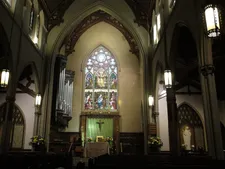 |
| Mark Bozek on Bill Cunningham: “He went to church every Sunday, same church that Jackie Kennedy went to church to at St. Thomas More.” Photo: Anne-Katrin Titze |
MB: Because he was so intelligent right when he got to New York in 1949. He hooked up with these women from Chez Ninon and surrounded himself and was just a sponge for history. Like no one else I'd ever met he could quote what someone showed in 1941 and what colour it was and what fabric it was.
AKT: Fabric is so important in his photos. He is on the street, right there. People now buy online, traditional stores with a long history disappear. The world is changing away from the on-the-street-ness that he represents.
MB: No question. The irony of that is that for the last couple of years street wear is all anyone talks about in the fashion world. This and that is street wear and [Kerby Jean-Raymond’s] Pyer Moss is street wear. Ironically, Willi Smith who was an African-American designer in the Eighties, his was called Street Couture. He was the first designer they referred that to.
AKT: Was Bill at Versailles '73?
MB: Yes he was. There's pictures in the movie. There's only two or three that had ever been released. So when I saw that file of photographs, I spent probably a week just looking at those pictures. Choosing Liza Minnelli and Pat Cleveland.
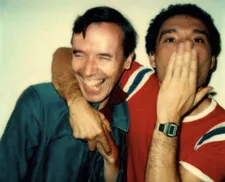 |
| Mark Bozek on Bill Cunningham with Antonio Lopez in James Crump's Antonio Lopez 1970: Sex Fashion & Disco: “I saw it many times. It's fantastic.” Photo: Juan Ramos |
AKT: It's interesting how he comments on movie stars. Ginger Rogers, Joan Crawford and Marilyn Monroe - not so much fashion sense. Leslie Caron was another one he mentioned.
MB: Joan Crawford didn't have style. "Not in her own life," he said. "Not like the movies."
AKT: Only Gloria Swanson manages to come close. Also the quote when he was at Chez Ninon about Liz Taylor. Liz Taylor came by once and "we didn't know what to do with her."
MB: Look, he was such a savant about fashion and history and the style that he learned from Chez Ninon was very very refined. A Brooke Astor, Jacqueline Kennedy kind of style that was different. He says it wasn't a matter of snobbishness, it was just a matter of taste. But he was really saying they [some celebrities] didn't have taste.
AKT: He took my photo three times. That I know of.
MB: He did? Wonderful! Were you in the paper as well?
AKT: Once.
MB: Oh fabulous. You remember what you were wearing? What day it was?
AKT: Absolutely. At the farmers’ market. I was wearing a plaid blouse and a grey jacket and I was so proud. Beyond.
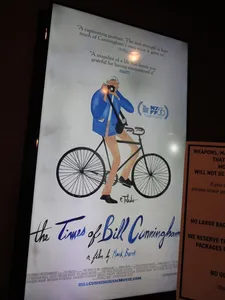 |
| The Times Of Bill Cunningham poster at Cinemas 1, 2 & 3 in New York Photo: Anne-Katrin Titze |
MB: And you are not alone. You can't imagine how many people remember the day . They also remember the day when he photographed them and they didn't make the paper.
AKT: Exactly.
MB: Just as much as when they did.
AKT: Once he took a picture of me in the lobby at The Times Building. And no, that did not make it.
MB: Ruben Toledo, he and Isabel - the film is dedicated to Isabel.
AKT: She died right after?
MB: Just this past August. But they used to have dinner with Bill every Saturday night at some cheesy diner near Carnegie Hall because he wouldn't eat in any other place that was known other than a cheesy diner. They said they would go with him every Saturday night and then he'd excitedly go to the newsstand when The Times would arrive.
They'd open up the pages and he'd ask "Do you like my pages?" That went on for years. On the Upper East Side particularly. The society women would rush down, they'd send their servants down there and they'd rip through to the style section to see "Oh, I was at the Public Library last week, I wonder if I made the pages." It was a whole science, a whole process, sort of like a game, people rushing for the paper.
AKT: The first hat he made was at ten years old for his mother. And she didn't wear it.
MB: I know! Sort of sad. But that was his thing from an early age. They weren't a fashion family at all. The opposite.
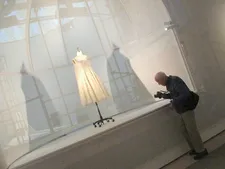 |
| Mark Bozek on Bill Cunningham and Pierre Houlès: “Pierre used to say to him every morning ‘Work well!’ And he was very close to Pierre.” Photo: Anne-Katrin Titze |
AKT: Church.
MB: Church was a very big deal till the end of his life. It meant a lot to him. I'm Catholic and we all have our own interpretation of what God means to us and Bill had his own. He went to church every Sunday, same church that Jackie Kennedy went to church to at St. Thomas More on the Upper East Side.
AKT: Do you know which street it is on?
MB: 89th Street? That was her small little church that Bill went to every Sunday.
AKT: The connection between church and fashion becomes clear. A first inspiration. André Leon Talley mentioned this also in a documentary [Kate Novack's The Gospel According to André]. The role of church in fashion and fashion in church.
MB: Oh yes, for African Americans going to church in Brooklyn and in the South - that was a serious fashion statement.
AKT: I remember too, as a child being bored, looking at what people are wearing.
MB: Look what Anna Wintour did two years ago at The Met. All about the effect of Catholicism and religion on fashion [Heavenly Bodies: Fashion and the Catholic Imagination].
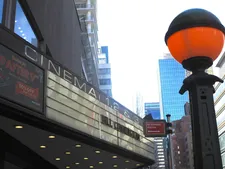 |
| The Times Of Bill Cunningham on the Cinemas 1, 2 & 3 marquee Photo: Anne-Katrin Titze |
AKT: I remember it very well and am also looking forward to the next one About Time: Fashion and Duration.
MB: At that exhibit [Catholic Imagination] I was right in the middle of making my movie. So I bought a camera from e-Bay that was shipped from Singapore, the exact same kind of camera that Bill first shot with, this Olympus [Pen] Half Frame camera. I'm not a photographer but I asked the people at Vogue to let me shoot on the red carpet when they came in. Click, there was no focus, no nothing, it was already lit and the pictures were amazing.
AKT: At the press preview for Manus x Machina: Fashion in an Age of Technology, that's the last time I saw Bill Cunningham.
MB: I think that was the last one he did, yes.
AKT: I have photos of him taking photos of the exhibit. In the dark in his jacket.
MB: And the jacket he wore was the jacket that Pierre Houlès gave him before he died [in 1986]. And he wore that jacket every single night. To every single black-tie event, that was his jacket.
The Times Of Bill Cunningham opened in the US on February 14.








